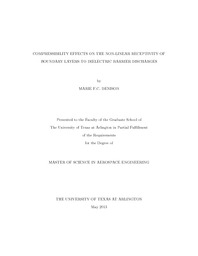
ATTENTION: The works hosted here are being migrated to a new repository that will consolidate resources, improve discoverability, and better show UTA's research impact on the global community. We will update authors as the migration progresses. Please see MavMatrix for more information.
Show simple item record
| dc.contributor.author | Denison, Marie F.C. | en_US |
| dc.date.accessioned | 2013-07-22T20:14:01Z | |
| dc.date.available | 2013-07-22T20:14:01Z | |
| dc.date.issued | 2013-07-22 | |
| dc.date.submitted | January 2013 | en_US |
| dc.identifier.other | DISS-12238 | en_US |
| dc.identifier.uri | http://hdl.handle.net/10106/11831 | |
| dc.description.abstract | The reduction of drag and aerodynamic heating caused by boundary layer transition is of central interest for the development of hypersonic vehicles. Receptivity to flow perturbation in the form of Tollmien-Schlichting (TS) wave growth often determines the first stage of the transition process, which can be delayed by depositing specific excitations into the boundary layer. Weakly ionized Dielectric Barrier Discharge (DBD) actuators are being investigated as possible sources of such excitations, but little is known today about their interaction with high-speed flows. In this framework, the first part of the thesis is dedicated to a receptivity study of laminar compressible boundary layers over a flat plate by linear stability analysis following an adjoint operator formulation, under DBD representative excitations assumed independent of flow conditions. The second part of the work concentrates on the development of a coupled plasma-Navier and Stokes solver targeted at the study of supersonic flow and compressibility effects on DBD forcing and non-parallel receptivity.The linear receptivity study of quasi-parallel compressible flows reveals several interesting features such as a significant shift of the region of maximum receptivity deeper into the flow at high Mach number and strong wave amplitude reduction compared to incompressible flows. The response to DBD relevant excitation distributions and to variations of the base flow conditions and system length scales follows these trends. Observed absolute amplitude changes and relative sensitivity modifications between source types are related to the evolution of the offset between forcing peak profile and relevant adjoint mode maximum. The analysis highlights the crucial importance of designing and placing the actuator in a way that matches its force field to the position of maximum boundary layer receptivity for the specific flow conditions of interest.In order to address the broad time and length scale spectrum inherent to the compressible flow-plasma problem, a solver has been developed using a novel Adaptive Mesh Refinement (AMR) algorithm based on the Chombo design for the solution of partial differential equations. Its embedded boundary formalism is utilized to solve the electrostatic potential in the complete domain including the DBD dielectric layer. The program allows accounting for non-equilibrium electron energization and resulting effect on transport and chemical reactions, with air or helium chemistry parametrization. Preliminary direct discharge test cases are reported for the latter. | en_US |
| dc.description.sponsorship | Massa, Luca | en_US |
| dc.language.iso | en | en_US |
| dc.publisher | Aerospace Engineering | en_US |
| dc.title | Compressibility Effects On The Non-linear Receptivity Of Boundary Layers To Dielectric Barrier Discharges | en_US |
| dc.type | M.S. | en_US |
| dc.contributor.committeeChair | Massa, Luca | en_US |
| dc.degree.department | Aerospace Engineering | en_US |
| dc.degree.discipline | Aerospace Engineering | en_US |
| dc.degree.grantor | University of Texas at Arlington | en_US |
| dc.degree.level | masters | en_US |
| dc.degree.name | M.S. | en_US |
Files in this item
- Name:
- Denison_uta_2502M_12238.pdf
- Size:
- 2.219Mb
- Format:
- PDF
This item appears in the following Collection(s)
Show simple item record


